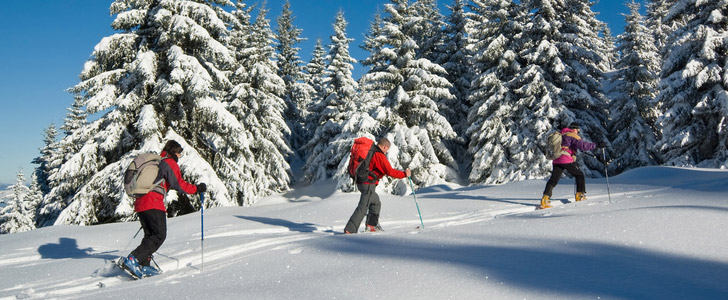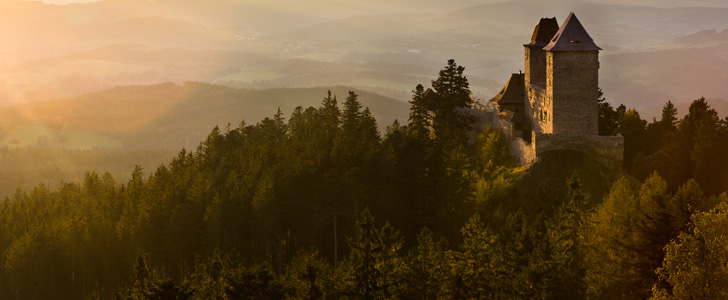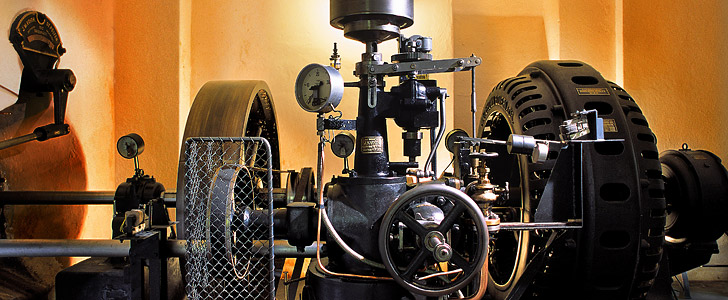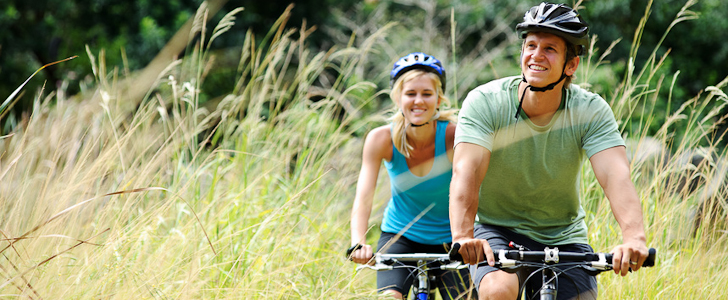Trips and sporting activities
The vicinity of Kašperské Hory, and therefore of Vogelsang as well, is ideal for trips and sporting activities. There are many cultural monuments close by.

The Kašperské Hory ski resort
Illuminated ski slope at Kašperské Hory on the Lišák mountain.
- 25 km away, 7 ski lifts and ski tows, 6 km of ski slopes, 2 of them artificially snowed, 3 illuminated ski slopes.
- Cross-country ski trails with a length of up to 85 km, accessible over the nearby Zhůří settlement.
The Kašperk castle
The gothic castle of Kašperk is 5 km north of Kašperské Hory. It was built by king Charles IV in 1356 for protection of nearby gold mines and the old trade road. Kašperk – originally named Karlsberg after its founder – is the highest-altitude royal castle in Bohemia. Another castle, Pustý hrádek, was built on the hill immediately to the east of Kašperk during the 15th century; probably for defense of this castle – it is now in ruins. Kašperk castle is open to the public during summer season, until the end of October.

The castle and palace Velhartice
It is located close to the route to Železná Ruda and towers steeply over the slope of the Borek mountain, which has a height of 853 m above sea level. The castles ruins are 14th century.
The Rabí castle
The ruin of the mediaeval castle is known for the fact that Jan Žižka lost his eye there in 1421. It is located 9 km to the northeast of Sušice.
The Giant’s castle
The Giant’s castle is a castle steeped in legend and an archaeological monument and is located about 1 km south of the Popelná settlement.
Antýgl Farmstead
The Antýgl farmstead, a timber yard and glassworks dating back to the early 16th century, is located in the Vydra valley at 928m above sea level on the road between Srní and Modrava. The glassworks, which had been in operation since 1523, was closed in the early 1800s. The name is derived from the German “ein Tiegel“ meaning “a skillet”. Antýgl is a typical example of Bohemian-Forest architecture.
Vltava Springs
The spring of the longes Czech river, the Vltava, is a few kilometers south west of the Kvilda township in the Bohemian Forest, at 1172m above sea level. The actual Vltava river is made up of several streams springs high up in inaccessible parts of Šumava National Park. The place of the symbolic spring can be reached on a sealed road marked with the blue tourist trail marker, or by bike via route 1041.

Timber Bridge
The 72-metre timber bridge on the Vydra river is s replica of the historic wooden bridge which was used to catch the floating timber by a system of rods and poles, forcing it into the sluiceway. The bridge is is the Rechle township at the start of a 6km tourist trail along the Tetov sluiceway. The trail is accessible to people with disabilities.
The Bohemian Forest Museum in Kašperské Hory
Permanent exhibition dedicated to the nature and history of life and work of the people in the Bohemian Forest.
The motorcycle museum in Kašperské Hory
Includes the exhibition “Czech toys”.
Čeňkova Pila
Exhibition “energy from the Bohemian Forest” in the building of the hydroelectric power station Vydra; The power station’s construction started in April 1937 and is connected with the name of the engineer Karel Koska.

Local circular walking trails (5-7 km)
The Kašperské Hory municipal information centre offers descriptions and maps (town hall on the marketplace).
- The car park in Žlíbek below the castle Kašperk is the starting point.
- During the winter they serve as cross-country ski trails.


